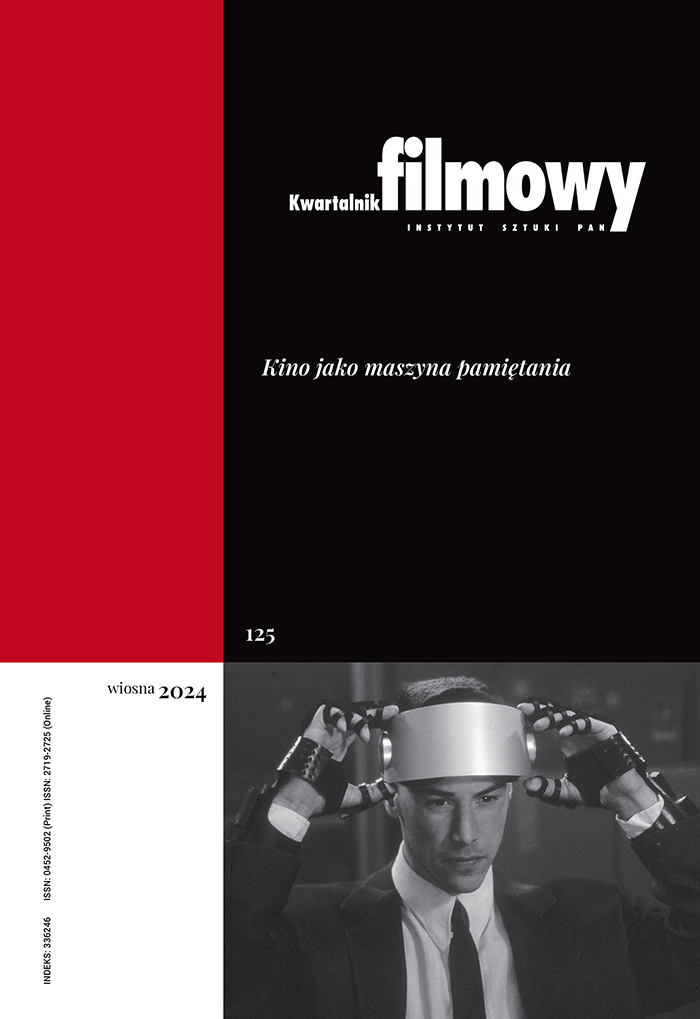The Magical Beginnings of Cinema
Abstract
This article has been inspired by two events: the exhibition of Werner Nekes’s collection of pre-cine- matic devises organized in conjunction with The New Horizons Festival in Wrocław, Poland (July-August, 2011), and the publication of the special issue of Animation: An Interdiscipinary Journal (July 2011) devoted to Pre- and Early Cinema. According to the editors of the issue, Andre Gaudreault and Philippe Gautier, the notorious question “who invented cinema” - Edison or the Lumiere brothers - is irrelevant, since cinema is a socio-cultural phenomenon that cannot be thought as “invented”. It emerged alongside the institutionalization of film around 1910. Thus early film, so called “cinema of attractions”, has more to do with pre-cinematic shows and devises like magic lanterns, etc., than fully developed entertainment of the later era. The author of this article, after presenting a short history of magic lanterns and their impact on selected poets, writers and filmmakers (e.g. Bergman and Starewicz), argues that linking the birth of cinema to the institutionalization of the medium obscures another important question: What constitutes film as a work of art? Polish filmmaker, philosopher, and writer Stefan Themerson also agreed in his essay of 1937 The Urge to Create Visions that the invention of the cinematograph had nothing to do with the inception of cinema but for him the latter was actually a much wider and older concept connected to the eternal human quest for all kinds of moving spectacles.
Keywords:
Werner Nekes, Stefan Themerson, beginnings of cinemaReferences
Bugaj Roman, Nauki tajemne w Polsce w dobie odrodzenia, Wrocław – Warszawa – Kraków – Gdańsk 1976, s. 175.
Google Scholar
Crafton Donald, The Veiled Genealogies of Animation and Cinema, „Animation: An Interdisciplinary Journal” 2011, nr 6, numer specjalny: Animation, Pre- and Early Cinema, s. 100.
DOI: https://doi.org/10.1177/1746847711404979
Google Scholar
Duda Artur, Teatralne i performatywne korzenie telewizji, „Pamiętnik Teatralny” 2010, nr 1-2, s. 172-197.
Google Scholar
Gaudreault André, Philippe Gautier, Special Issue: Could Kinematography Be Animation and Animation Kinematography?, „Animation: An Interdisciplinary Journal” 2011, nr 6, numer specjalny: Animation, Pre- and Early Cinema, s. 86.
DOI: https://doi.org/10.1177/1746847711408232
Google Scholar
Gautier Philippe, A Trick Question: Are Early Animated Drawings a Film Genre or a Special Effect?, „Animation: An Interdisciplinary Journal” 2011, nr 6, numer specjalny: Animation, Pre- and Early Cinema, s. 163-175.
DOI: https://doi.org/10.1177/1746847711407624
Google Scholar
Giżycki Marcin, Walka o film artystyczny w międzywojennej Polsce, PWN, Warszawa 1989, s. 224.
Google Scholar
Goethe Johann Wolfgang, Cierpienia młodego Wertera, tłum. L. Staff, Warszawa 1956, s. 41.
Google Scholar
Jewsiewicki Władysław, Ezop XX wieku, Warszawa 1989, s. 14-15.
Google Scholar
Kuczkowski Feliks, Wspomnienia o filmie przyszłości, Warszawa 1955, maszynopis w zbiorach Filmoteki Narodowej, sygnatura A-129.
Google Scholar
Meyrink Gustav, Golem, tłum. A. Lange, Warszawa 1992, s. 45.
Google Scholar
Miłosz Czesław, Moja wierna mowo, w tenże: Wiersze, Kraków – Wrocław 1985, s. 181.
Google Scholar
Morawski Franciszek, Latarnia magiczna, w tenże: Latarnia magiczna – bajki i fraszki, Warszawa 1953, s. 80.
Google Scholar
Sieroszewski Wacław, Pan Twardost-Twardowski. Czarnoksiężnik polski. Powieść historyczna, Warszawa 1930.
Google Scholar
Themerson Stefan, O potrzebie tworzenia widzeń, „f.a.” 1937, nr 2.
Google Scholar
Authors
Marcin Giżyckikwartalnik.filmowy@ispan.pl
Rhode Island School of Design United States
Krytyk i historyk sztuki; autor książek z dziedziny historii filmu i zjawisk kultury artystycznej. Wykładowca w Rhode Island School of Design w USA. Opublikował m.in. Nie tylko Disney - rzecz o kinie animowanym (2000), Koniec i co dalej? (2001), Słownik kierunków, ruchów i kluczowych pojęć sztuki drugiej połowy XX wieku (2002), Wenders do domu! Europejskie filmy o Ameryce i ich recepcja w Stanach Zjednoczonych (2006).
Statistics
Abstract views: 1372PDF downloads: 139
License
Copyright (c) 2011 Marcin Giżycki

This work is licensed under a Creative Commons Attribution 4.0 International License.
The author grants the publisher a royalty-free non-exclusive licence (CC BY 4.0) to use the article in Kwartalnik Filmowy, retains full copyright, and agrees to identify the work as first having been published in Kwartalnik Filmowy should it be published or used again (download licence agreement). The journal is published under the CC BY 4.0 licence. By submitting an article, the author agrees to make it available under this licence.
In issues from 105-106 (2019) to 119 (2022) all articles were published under the CC BY-NC-ND 4.0 licence. During this period the authors granted a royalty-free non-exclusive licence (CC BY-ND 4.0) to use their article in „Kwartalnik Filmowy”, retained full copyright, and agreed to identify the work as first having been published in our journal should it be published or used again.
Most read articles by the same author(s)
- Marcin Giżycki, Smartphone – The Triumph of Eisenstein , Kwartalnik Filmowy: No. 112 (2020): Polish Documentary, Polish Animation
- Marcin Giżycki, … Only Stills Remained: Nonexistent Films of Cindy Sherman , Kwartalnik Filmowy: No. 115 (2021): Form Film, Content Film
- Marcin Giżycki, „L’âge d’or” – the Masterpiece of Provocation , Kwartalnik Filmowy: No. 109 (2020): Architectural Space in Film
- Marcin Giżycki, The Last Wizard of Western World , Kwartalnik Filmowy: No. 34 (2001): Cinema at the Turn of the Century
- Marcin Giżycki, Why I Do Not Like Advertising in the Cinema , Kwartalnik Filmowy: No. 105-106 (2019): Cinema and Political Transformation
- Marcin Giżycki, Expanded Cinema Thirty Years Later , Kwartalnik Filmowy: No. 35-36 (2001): Cinema and New Media
- Marcin Giżycki, The Highs and Lows of Animation in Bohemia , Kwartalnik Filmowy: No. 81 (2013): Child in Film
- Marcin Giżycki, The Revenge of Joker and Parasites , Kwartalnik Filmowy: No. 108 (2019): Film Production and Distribution
- Marcin Giżycki, Tucker and Others , Kwartalnik Filmowy: No. 110 (2020): Beyond Human Being
- Marcin Giżycki, The Artist in a Haunted House: Jeremy Blake and the Winchester Mystery House , Kwartalnik Filmowy: No. 97-98 (2017): Wandering Motifs











